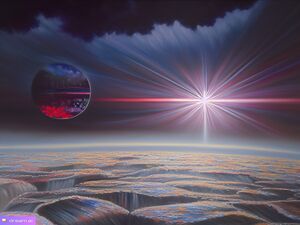
| Type: | M6V Red Dwarf |
| Radius: | 2.51 x 105 km (0.36 of Sol) |
| Mass: | 4.35 x 1029 kg (0.22 of Sol) |
| Temperature: | 2400 K |
| Luminosity: | 1.48 x 1024 W (0.0003 of Sol) |
| Ecosphere: | Between 0.045 and 0.124 AU |
| Location: | Ataraddon Sector 1.1 ly from the Winovin Star System 2.2 ly from the Las Miranonine Sector |
The Sotaleko Star System revolves around a small and cool M6V Red Dwarf star. It consists of just two small planets, Sotaleko Prime and Sotaleko 2. Despite being unremarkable in terms of its planetary composition, neither of the planets is suitable for supporting life. Sotaleko Prime, a frozen world with active geological features, maintains a thick atmosphere mainly composed of oxygen, nitrogen, and argon. However, its surface is covered in permanent glaciers heavy in frozen hydrocarbons. On the other hand, Sotaleko 2 is a barren and desolate planet with a thin atmosphere primarily made up of hydrocarbons and oxygen. Both planets lack the necessary conditions for sustaining life, and the cool nature of the star prevents them from being viable candidates for terraforming endeavors. The system was surveyed in 2387 by the Avali on behalf of Solas Tempus and the Hermod Outpost, Sotaleko Terminal, was installed on the 1st planet that same year.
Sotaleko 1
| Class: | P |
| Distance: | 1.66 x 107 km (0.11 AU) |
| Period: | 2.88 Days |
| Radius: | 7,298.05 km (1.15 of Earth) |
| Gravity: | 1.22 G |
Sotaleko 1 is a frozen world that boasts several unique and intriguing features. Covered in glaciers and exhibiting ongoing geological activity, the planet experiences regular volcanic eruptions and small tectonic shifts. These volcanic outgassings play a crucial role in maintaining a relatively warm atmosphere, preventing the planet from freezing altogether. The thick permanent glaciers on the surface are rich in frozen hydrocarbons, adding to the planet's distinct character. The atmosphere of Sotaleko 1 is thick and primarily composed of argon, nitrogen, and oxygen, with a surface temperature around -20°C and a pressure approximately 1.5 times that of Earth at 152 kPa.
The Hermod Outpost Sotaleko Terminal is located on this planet.
Beneath the ice-covered surface, a remarkable subglacial ocean exists, fostering the development of aquatic life. This includes various species of algae, bacteria, and even higher organisms such as Ctenophora and Thaliacea. Many of these organisms exhibit bioluminescent qualities, adding a stunning display of light to the otherwise frozen environment. Additionally, small creatures resembling glacier ice worms burrow into the ice to extract oxygen, while closer to the sea floor, oxygen becomes abundant.
Unique Features
- Glacial Blue Glow
- One of the peculiar phenomena observed on Sotaleko 1 is the ethereal blue glow emitted by the thick glaciers that cover its surface. Under certain lighting conditions, perhaps influenced by the planet's atmospheric composition or the interaction between sunlight and the frozen hydrocarbons, the glaciers emanate a soft, eerie blue luminescence. This mesmerizing phenomenon adds a touch of otherworldly beauty to the frozen landscape, casting an enchanting glow across the icy terrain.
- Whispering Winds
- Sotaleko 1 is known for its unusual atmospheric acoustics. When gentle breezes blow across the planet's frozen surface, a unique phenomenon occurs—the winds carry faint, melodic whispers. Scientists believe that the combination of the dense atmosphere, the composition of gases, and the intricate patterns of the glaciers creates a peculiar resonance that results in these whispered sounds. The ethereal whispers have captivated explorers and researchers, sparking debates and investigations into the underlying mechanisms behind this atmospheric symphony.
- Subterranean Crystal Caverns
- Hidden beneath the surface of Sotaleko 1 lie vast networks of crystal caverns, a marvel of natural architecture. These subterranean formations, created through intricate geological processes over millennia, house dazzling arrays of luminous crystals that illuminate the chambers with a surreal glow. The crystals, composed of unique mineral compositions influenced by the planet's geothermal activity, refract light in mesmerizing patterns, creating a mesmerizing spectacle for any intrepid explorers venturing into the depths. The crystal caverns present an otherworldly beauty and a potential source of valuable minerals and scientific intrigue.
Sotaleko 2
| Class: | P |
| Distance: | 3.10 x 107 km (0.21 AU) |
| Period: | 74.58 Days |
| Radius: | 7,971.17 km (1.25 times Earth) |
| Gravity: | 0.65 G |
Sotaleko 2 is a barren world with a thin atmosphere composed mainly of hydrocarbons and oxygen. The planet's geological activity is minimal due to its apparent age, but it has sustained numerous impact craters that have contributed to the mix of gases present in the atmosphere. The surface temperature of Sotaleko 2 is only slightly higher than that of liquid oxygen, indicating extremely cold conditions. The planet's distance from the cool star has limited its heat source, resulting in frigid temperatures across the surface. The surface temperature is -195 C with a surface pressure of 9.87 times that of Earth or 10 MPa (megapascals).
The thick layers of frozen hydrocarbons and layers of ice cover the surface, giving it a distinct composition. The impact craters found throughout the planet's terrain have played a crucial role in the planet's atmospheric composition. Each impact releases sublimated gases, including hydrocarbons and other volatile compounds, which contribute to the thin atmosphere. However, the lack of substantial geological activity prevents the replenishment of these gases from the planet's interior.
Unique Features
- Frozen Geysers
- One remarkable aspect of Sotaleko 2 is the presence of frozen geysers scattered across its surface. Despite the planet's limited geological activity, certain regions experience periodic eruptions of volatile substances from beneath the frozen layers. These eruptions propel jets of sublimated gases and fine icy particles into the air, creating spectacular frozen geysers that reach varying heights before falling back and freezing once again.